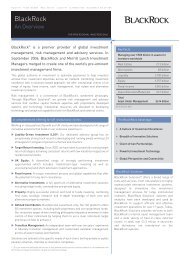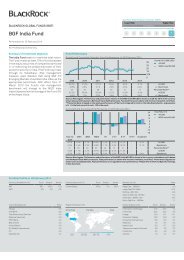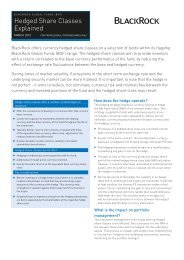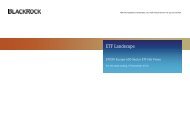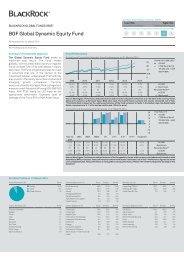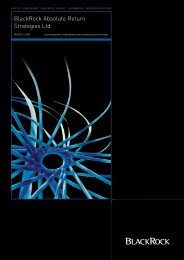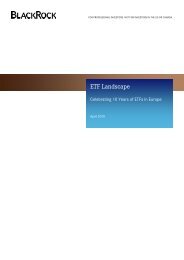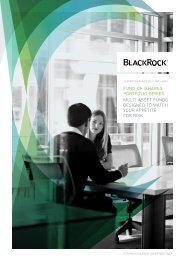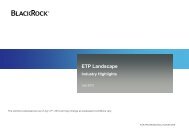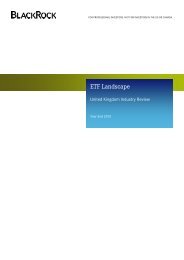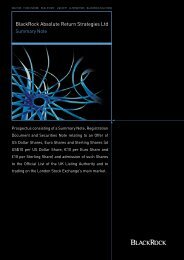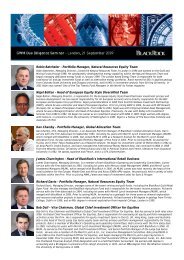Swing Pricing - BlackRock International
Swing Pricing - BlackRock International
Swing Pricing - BlackRock International
- No tags were found...
You also want an ePaper? Increase the reach of your titles
YUMPU automatically turns print PDFs into web optimized ePapers that Google loves.
The results below highlight the most significant performance impacts across the BGF range<br />
Number of<br />
<strong>Swing</strong>s during<br />
the period<br />
Base ccy<br />
price at<br />
beginning<br />
of period<br />
Base ccy<br />
price<br />
30 June 2011<br />
Class Base<br />
Performance<br />
Performance<br />
without<br />
<strong>Swing</strong>ing<br />
Performance<br />
benefit<br />
BGF Asian Tiger Bond Fund 72 27.25 29.19 7.11% 4.59% 2.52%<br />
BGF Global High Yield Bond Fund 60 14.59 16.79 14.24% 12.11% 2.13%<br />
BGF US Dollar High Yield Bond Fund 42 19.69 22.64 14.94% 14.25% 0.69%<br />
BGF World Technology Fund 12 10.39 13.33 28.34% 27.89% 0.45%<br />
BGF Emerging Markets Bond Fund 32 11.67 12.88 10.38% 9.97% 0.41%<br />
BGF China Fund 42 11.19 12.69 13.35% 12.95% 0.40%<br />
The study on the BSF range found similarly compelling results. We again highlight the most significant<br />
Number of<br />
<strong>Swing</strong>s during<br />
the period<br />
Base ccy<br />
price at<br />
beginning<br />
of period<br />
Base ccy<br />
price<br />
30 June 2011<br />
Class Base<br />
Performance<br />
Performance<br />
without<br />
<strong>Swing</strong>ing<br />
Performance<br />
benefit<br />
BSF Latin American Opportunities Fund 20 112.95 149.9 32.71% 30.48% 2.24%<br />
BSF European Opportunities Absolute Return Fund 10 100 101.4 1.40% 0.65% 0.75%<br />
BSF Fixed Income Strategies Fund 14 100.78 103.35 2.55% 2.06% 0.49%<br />
BSF European Diversified Equity Absolute Return Fund 28 101.82 112.4 10.39% 9.95% 0.44%<br />
BSF European Opportunities Extension Strategies Fund 6 88.11 104.88 19.03% 18.62% 0.41%<br />
BSF European Credit Strategies Fund 7 118.81 113.64 -4.35% -4.73% 0.38%<br />
Source: <strong>BlackRock</strong>, August and November 2011.<br />
The funds’ performance would have been diluted (reduced) by<br />
the amounts shown in the final column had we not protected it<br />
by using price swinging.<br />
Investors that trade at a swung price are effectively paying the dealing<br />
costs associated with their activity. Applying swing pricing to a fund’s<br />
traded NAV is not done for the benefit of fund promoters or service<br />
providers but solely to protect existing investors’ interests.<br />
A governance-led process – How <strong>BlackRock</strong><br />
sets its thresholds<br />
Every one of our funds in the BGF and BSF ranges has an individual<br />
swing threshold and impact fee (the amount by which the NAV<br />
is swung). Both are dependent on the liquidity of the underlying<br />
markets in which a particular fund invests. This means that the swing<br />
amount will differ across asset classes and regions, and is likely<br />
to be lower in more mainstream or developed markets. Thresholds<br />
and impact fees are set by <strong>BlackRock</strong>’s <strong>Swing</strong>ing Committee, which<br />
meets at least monthly, but may do so more regularly if market<br />
conditions require. These meetings capture our best estimate of<br />
actual trading costs, and review the current levels of protection<br />
provided by swinging to understand if they remain relevant.<br />
The thresholds are confidential, as is generally the case in the<br />
industry, in order to prevent any attempt to avoid a price swing by<br />
dealing in an amount just below the threshold. However, we are<br />
happy to discuss our impact fees with clients, giving them a clear<br />
understanding of the impact their trading activity may have.<br />
It is worth noting that unforeseen events, like the collapse of Lehman<br />
Brothers in September 2008, or the more recent euro crisis of<br />
2010/2011, can cause risk aversion to spike, meaning that market<br />
liquidity evaporates and dealing costs rise accordingly. In such<br />
scenarios, impact fees should be expected to be increased, and/or<br />
thresholds lowered, by the <strong>Swing</strong>ing Committee in order to provide<br />
the appropriate level of protection in the new conditions.<br />
Conclusion<br />
<strong>BlackRock</strong> has pursued its simple, but specific, approach to fund<br />
performance dilution for a number of years, reflecting its status<br />
as a pioneer. Our policy is solely about protecting the interests of<br />
investors, and we should emphasise again that when an investor is<br />
impacted by a price swing in subscribing to, or redeeming from, a<br />
fund they are only paying/receiving a fair price, taking into account<br />
the costs of dealing. Ultimately, investors would have to bear these<br />
costs themselves if they were dealing in the underlying securities<br />
direct. These are the costs of investing and they have to be borne.<br />
Our investors are not being treated unfairly.<br />
We believe that we can demonstrate that funds that apply swing<br />
pricing will show superior performance over time compared to<br />
those (with identical investment strategies and trading patterns)<br />
that do not.



